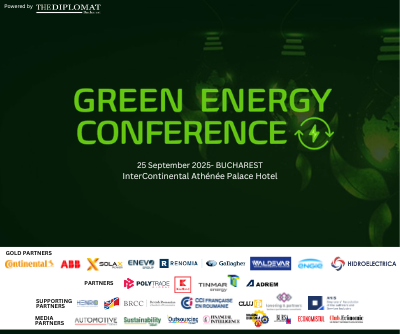Romania’s land market, dominated by local investors, is adapting to an uncertain climate: Colliers

Despite the challenging backdrop, marked by political and economic uncertainty, the Romanian land market reached a solid transaction volume of 450 million Euros in 2024, broadly comparable to the previous year, as per Colliers estimates. The real estate consultancy tracks deals involving land plots for commercial real estate projects, usually in an urban setting. The sector continued thus to demonstrate significant momentum through some representative large transactions, including the completion of deals initiated in previous years, despite the subdued overall activity of newly initiated deals.
The 2024 transaction volume, estimated at approximately 450 million euros, comprises mixed-use assets, land bundled with income-generating projects, and partnerships such as land swaps or joint ventures. These complexities make it challenging to accurately assess market value, according to Colliers consultants, who note that the overall level is broadly comparable to 2023, despite a somewhat lower number of transactions. Local investors maintained a dominant position in the market, while international investors adopted a more cautious stance, influenced by uncertainties surrounding political stability and economic developments. Demand remained concentrated in the residential sector, particularly in Bucharest and its metropolitan area, as well as in major regional cities, where buyers seized opportunities to acquire high-value land.
“The expectations for the year were modest, with investors and developers taking a cautious stance due to uncertainties surrounding election outcomes, uncertain government policies and economic indicators such as interest rates and inflation. In Bucharest, as well as in several large regional cities, administrative bottlenecks have significantly delayed transactions. Many acquisition decisions were tied to sales from existing portfolios, reflecting shifts in strategy. Some investors exited properties that no longer aligned with their current business plans and redirected their focus toward acquisitions that matched new objectives. Administrative hurdles and challenges in obtaining planning permission remain the primary factors constraining market activity”, explains Sînziana Oprea, Director Land Agency at Colliers Romania.
Although demand in the land market was moderate in 2024, it remained diverse, spanning sectors such as residential, retail, hotels, medical, industrial, energy, or agribusiness. Bucharest and its metropolitan area dominated the market, accounting for 80% of transaction volume, with the residential sector contributing 70% of this level. Significant purchases included platforms such as Roca on Preciziei Boulevard, Muntenia on Progresului Boulevard, and large plots in the Sisești area designated for residential projects. High interest was also noted in urban areas like Pipera, Corbeanca, Buftea, and Snagov, as well as in plots with building permits or PUZs, due to the opportunity to bypass urban planning bottlenecks, according to Colliers consultants.
The retail sector, accounting for approximately 20% of the market volume, was shaped by the completion of older transactions, such as the sale of the Helitube and Filan platforms in Bucharest. It was also influenced by the acquisition of land for retail parks and shopping galleries in various cities across the country. In the office sector, notable transactions included One United Propertie’s acquisition of the Romaero site through auction, along with several strategic purchases aimed at potential office developments within some mixed-use schemes in the future.
Outside Bucharest, demand for residential land grew, particularly in cities such as Timișoara, Brașov, and Constanța, where mixed-use projects are also in the planning stages. The retail sector concentrated on retail parks and strategic extensions, while many large plots of land outside urban areas, previously designated for residential development, attracted interest from investors in renewable energy, logistics, and agribusiness due to more affordable prices.
Romanian investors were the most active land buyers in 2024, followed by international retailers. While the market was more subdued, it continued to provide diverse opportunities tailored to the evolving economic landscape.
“Land supply increased in 2024, driven by some cash-strapped owners and developers who adjusted their strategies by selling parts of their portfolios. Long-standing auction listings were finally completed, and areas near the hubs of Bucharest’s A0 ring-road highway emerged as new investment hot spots. By adapting and repositioning their strategies, investors successfully diversified their opportunities, keeping the market balanced. Interest in joint venture partnerships also grew, with developers adopting this approach to lower their risk exposure, particularly for land that cannot be developed immediately. This trend highlights the market’s adaptability and the quest for medium- and long-term solutions”, underlines Sînziana Oprea.
Colliers consultants observed greater flexibility from landowners in 2024 transactions, both in pricing and payment structures. Strategic land with approved planning documentation maintained or even increased its value, while land in less desirable areas or with challenges related to obtaining planning permission experienced declines of up to 30-40% over a year ago.
For the year ahead, the appetite for land investment will largely depend on political and administrative stability. Recent bottlenecks have delayed several transactions, but many of these are expected to be finalized in the first half of 2025. Despite ongoing uncertainties, Romania’s long-term development potential will also attract new international investors, while local investors are expected to remain active, continuing to secure strategic assets. Most property owners are well-capitalized and prefer to wait for more favorable market conditions, while buyers are taking advantage of opportunities to secure the best deals. Investors who take risks during this period of uncertainty, concludes Sînziana Oprea, can achieve significant medium to long-term benefits, as the Colliers director expects economic recovery to bring substantial value appreciation.















